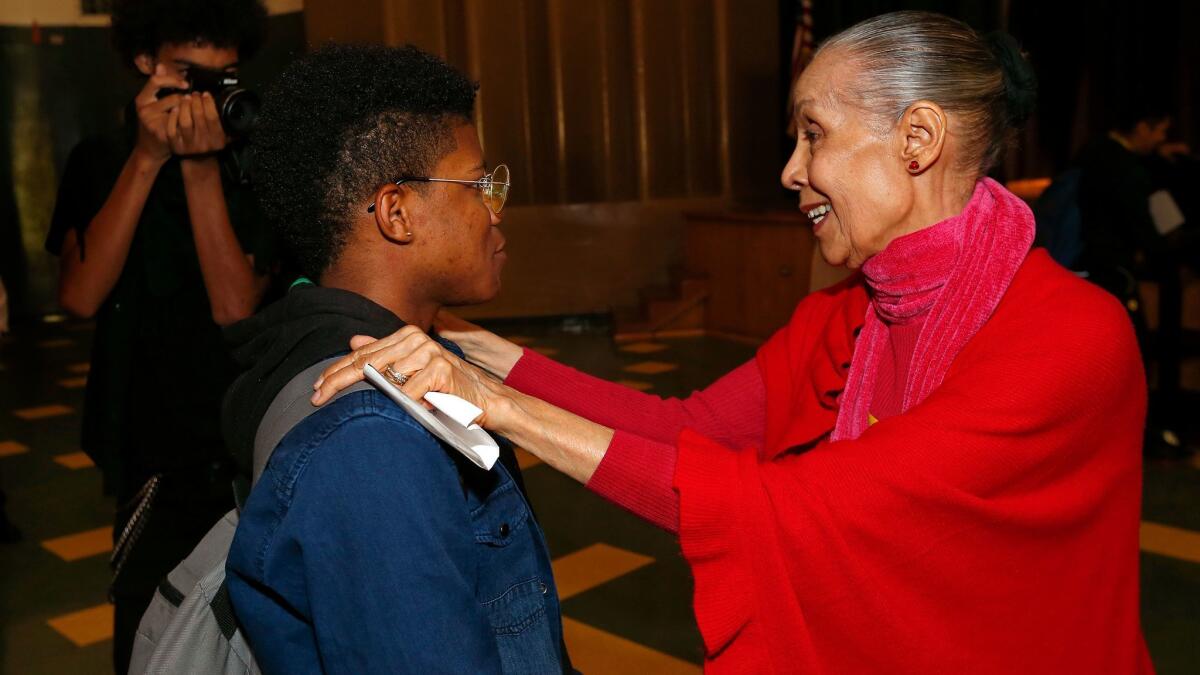Black dance legend, 85, returns to South L.A. high school with a message not all kids bother to hear

Carmen de Lavallade returned to Thomas Jefferson High, the South L.A. high school from which she graduated in 1948. She attended with famed choreographer Alvin Ailey and got serious about dance — serious enough that both would go on to become famous
- Share via
Carmen de Lavallade on Wednesday returned to the South L.A. school she graduated from in 1948: Thomas Jefferson High, where she attended with Alvin Ailey and got serious about dance — serious enough that both would go on to become world famous, noted for having immense talent and also for breaking racial boundaries that sought to hold them back.
Tall, slender and elegant with her hair pulled back in a tight bun and a bright red scarf around her swan-like neck, De Lavallade, now 85, choked up when she first began to speak at a morning assembly.
“I can’t tell you what this means to me,” she told students. “I was you. Alvin was you. You are a part of that history, and you will be a part of that history, and don’t let anybody tell you different.”
When De Lavallade attended Thomas Jefferson, the fourth-oldest school in the Los Angeles Unified School District, the student body was about 80% African American, she said. Now it’s mostly Latino.
By 11 a.m., those students had filed into the aged Art Deco auditorium, backpacks slung on shoulders, earbuds planted firmly in ears. They had to be told to pull down their sweatshirt hoods by their principal, who said he knew they used the hoods to hide their earbuds.
We came through times when everybody told us we couldn’t do it, and we believed it. Don’t you believe it.
— Carmen de Lavallade
De Lavallade would speculate later that they used their hoods to hide themselves.
“I seem like this person who came from outer space, but they are in the same situation I was in,” De Lavallade would later say in an interview.
“I don’t know their backgrounds; I can tell it’s been rough,” she said. “But they’re all beautiful. They’ve all got crowns on their heads.”
She told the students as much, over and over again: You are royalty.
She shared with the students an anecdote about how she wasn’t allowed to dance with her partner on “something called ‘The Ed Sullivan Show’” because the partner was white.
As she talked about making her life’s path as an artist of color, about how the students were part of her history, about how students could make their own history. She asked, “Do you understand?”
“Yes ma’am!” hollered a class clown in the center row. A student slept behind him. A few others snickered. It was a tough crowd.
But others were listening, watching the dancer before them with guarded interest.
De Lavallade kept asking if anybody had questions for her, but no one would raise a hand. Undeterred, she continued.
“We came through times when everybody told us we couldn’t do it, and we believed it,” she said. “Don’t you believe it.”
She told students that cellphones were tools not toys, that they should look beyond the screens in front of their faces and at the big, wide world around them. She told them about seeing television for the first time, about learning to duck and cover because of the atom bomb, about Hitler and Mussolini, about Gustavo Dudamel and Diego Rivera.
“People are people all over the world. Don’t let anybody tell you who you can be. Do you understand?” she asked again.
“Yes ma’am!” shouted the clown.
She asked students to raise their hands if they liked to read. No hands went up.
She asked them to raise their hands if they were artists. Only four or five hands went up.
She asked about who wanted to be in science. No hands went up.
She asked who went to museums. No hands.
She asked how many wanted to be dancers.
The clown raised his hand. “You know me!” he said merrily.
At the end of her talk, De Lavallade leaned forward and said she wanted to share something that her husband, the actor and dancer Geoffrey Holder, had said.
“Listen closely, pay attention. I’m going to say something that might save your life,” she said before carefully feeding them a quote: “I walk through doors. If I’m not wanted in a place, there’s something wrong with the place, not me.”

After the lunch bell rang and most students filed out into the bright sunshine, two students remained. One was a 14-year-old African American freshman named Brandon Robinson. Small and slight with glasses and a gentle voice, Robinson waited to shake De Lavallade’s hand and was enveloped in a hug instead.
Robinson loves dancing, singing and acting. He said he became “business minded” about the arts at age 9. He was excited to see De Lavallade speak and said her message held great value to him.
“She said not to listen to other people, which especially for me, being bullied, it really touched me at the heart,” he said.
The other remaining student was 16-year-old Reyna Soriano. She had bravely danced a solo as part of an introduction and welcome to De Lavallade, who on Thursday will talk to the kids at another one of her old schools, Vernon City Elementary.
Reyna said she is hoping to start a dance team at Jefferson. There is no dance program at the school.

ALSO:
New exhibition in Pasadena peeks into Picasso’s states of mind
Inuit throat singer Tanya Tagaq joins feminist performance series at the Broad
These rainstorms are made of xylophones and chicken wire but L.A. will take them
More to Read
The biggest entertainment stories
Get our big stories about Hollywood, film, television, music, arts, culture and more right in your inbox as soon as they publish.
You may occasionally receive promotional content from the Los Angeles Times.











